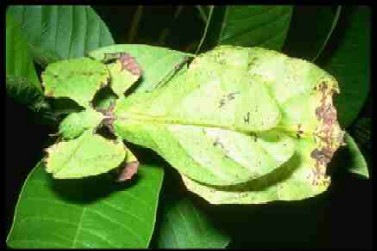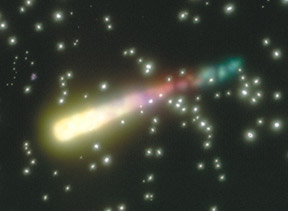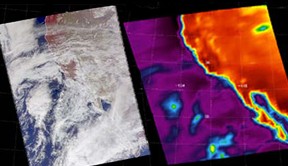These penguins live near the coast of Antarctica.
Click on image for full size
GSFC/NASA
A Perfect Place for Penguins!
News story originally written on October 10, 2003
Scientists have been studying special places of the chilly ocean near Antarctica. They found that these places are favorite spots for thousands of penguins!
Much of the ocean near Antarctica is covered with ice, but these special areas are not. That's what makes them special! Without a cover of ice, sunlight can hit the ocean water. This causes tiny floating algae called phytoplankton to grow and reproduce.
A tiny, shrimp-like animal called krill eats the phytoplankton. Since there is so much phytoplankton, the little krill munch away and reproduce until there are tons of them. Penguins like to eat the krill. So, where there are many krill, there are also many penguins!
These special places in the ocean are impossible to see from ships because they are surrounded by ice. So, to study them, scientists used two satellites. The satellites looked at the amount of phytoplankton in the ocean water. Where they found lots of phytoplankton, krill and penguins were living there too!
Last modified December 2, 2003 by Lisa Gardiner.
You might also be interested in:

Scientists have been studying special places of the chilly ocean near Antarctica. They found that these places are favorite spots for thousands of penguins! Much of the ocean near Antarctica is covered
...more
Mount St. Helens, a volcano on the west coast of the United States, has been quiet for 18 years. But in the last week it has not been quiet at all! It has been puffing steam and ash and a flow of lava
...more
Wonder why you never see a dinosaur in your yard? Well, they are extinct of course! So, there are no more of them living on Earth. Dinosaurs became extinct 65 million years ago. They were not the only
...more
A large meteor exploded in the sky near Chicago shortly after midnight on March 28, 2003. People in Wisconsin, Illinois, Indiana, and Ohio saw the meteor break apart as it flew across the sky. Many pieces
...more
Look at this picture! The light blue parts are coral reefs just under the water’s surface. How many reefs do you see? The crew of the International Space Station (ISS) took this picture while looking
...more
There will be an eclipse of the Moon on Thursday night, May 15, 2003. The shadow of the Earth will fall on the Moon, and the Moon will get dark! The Moon will not be so dark that you can't see it. The
...more
Figuring out what tomorrow's weather will be can be a tough job. But now scientists have made a new tool that will make it easier. It looks at the weather from above! The tool is orbiting Earth aboard
...more














